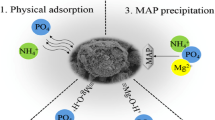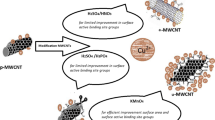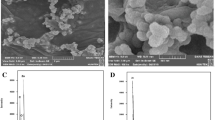Abstract
The removal of phosphate from water is vital in controlling eutrophication. Adsorption is one of the most popular technologies for removing phosphate. In this study, two types of nanoparticles (NPs), namely carbon nanotubes (CNTs) and copper oxide (CuO), were used and their phosphate removal potential was investigated. The physical and chemical properties of the two NPs were systematically studied using X-ray diffraction (XRD), scanning electron microscopy (SEM), FTIR, energy-dispersive X-ray (EDX), and BET methods. The image analyses of SEM indicated that CuO NPs and CNTs were nano-structured aggregates with mean diameters of about 85.0 and 22.2 nm, respectively. The sorption kinetic data were better described by the pseudo-second-order equation indicating its chemisorption nature. The equilibrium sorption data were well fitted into the Freundlich model for CNTs but for CuO, sorption data were better fitted into Langmuir isotherm model. The phosphate sorption capacities without the presence of competing anions were 15.4 and 23.9 mg/g (PO4 3−-P) for CNTs and CuO, respectively. Besides, the competing anions (Cl−, NO3 −, and humic acid) decreased the phosphate removal of CNTs and CuO. The negative values of the Gibbs’ free energy change (ΔG°) demonstrated the spontaneous nature of the sorption process in both sorbents, while the positive values of the enthalpy change (ΔH°) indicated that the sorption process was endothermic in nature. Overall, the results of this study suggest that CuO NPs and CNTs in a single solution have the potential to act as effective sorbents of phosphate under optimum conditions, respectively.








Similar content being viewed by others
References
Alizadeh-Gheshlaghi E, Shaabani B, Khodayari A, Azizian-Kalandaragh Y, Rahimi R (2012) Investigation of the catalytic activity of nano-sized CuO, Co3O4 and CuCo2O4 powders on thermal decomposition of ammonium perchlorate. Powder Technolo 217:330–339
Azizian S (2004) Kinetic models of sorption: a theoretical analysis. J Colloid Interface Sci 276:47–52
Bessarabov A, Bulatov I, Kvasyuk A, Kochetygov A (2010) Utilization of waste for large capacity productions of phosphorus-containing products based on the system analysis methods. Clean Technol Environ Policy 12:601–611
Biswas BK, Inoue K, Ghimire KN, Harada H, Ohto K, Kawakita H (2008) Removal and recovery of phosphorus from water by means of adsorption onto orange waste gel loaded with zirconium. Bioresour Technol 99:8685–8690
Boujelben N, Bouzid J, Elouear Z, Feki M, Jamoussi F, Montiel A (2008) Phosphorus removal from aqueous solution using iron coated natural and engineered sorbents. J Hazard Mater 151:103–110
Chen N, Feng C, Yang J, GaoY Li M, Zhang B (2013) Preparation and characterization of ferric-impregnated granular ceramics (FGCs) for phosphorus removal from aqueous solution. Clean Technol Environ Policy 15:375–382
Chen L, Zhao X, Pan B, Zhang W, Hua MG, Lv L, Zhang W (2015) Preferable removal of phosphate from water using hydrous zirconium oxide-based nanocomposite of high stability. J Hazard Mater 284:35–42
Chiban M, Benhima H, Saadi B, Nounah A, Sinan F (2005) Isotherms and kinetic study of dihydrogen and hydrogen phosphate ions (H2PO4 − and HPO4 2−) adsorption onto crushed plant matter of the semi-arid zones of Morocco: asphodelus microcarpus, Asparagus albus and Senecio anthophorbium. J Phys IV 123:393–399
Chiban M, Soudani A, Sinan F, Persin M (2011) Characterization and application of dried plants to remove heavy metals, nitrate and phosphate ions from industrial wastewaters in a batch system. Clean: soil, air, water 39:283–376
Chiban M, Soudani A, Sinan F, Persin M (2012) Wastewater treatment by batch adsorption method onto micro-particles of dried Withania frutescens plant as a new adsorbent. J Environ Manag 95:S61–S65
Eaton AD, Franson MAH, Association AWW, Federation WE (2005) Standard methods for the examination of water and wastewater, 21st edn. American Public Health Association, Washington, DC
Goldberg S (2005) Equations and models describing adsorption processes in soils. In: Tabatabai MA, Sparks DL (eds) Chemical processes in soils. Soil Science Society of America, Madison, PP 489–518
Groenenberg JE, Chardon WJ, Koopmans GF (2013) Reducing phosphorus loading of surface water using iron-coated sand. J Environ Qual 42:250–259
Kilpimaa S, Runtti H, Kangas T, Lassi U, Kuokkanen T (2014) Removal of phosphate and nitrate over a modified carbon residue from biomass gasification. Chem Eng Res Des 92:1923–1933
Kondratyuk P, Yates J (2007) Molecular views of physical adsorption inside and outside of single-wall carbon nanotubes. Acc Chem Res 40:995–1004
Lalley J, Han C, Mohan GR, Dionysiou DD, Speth TF, Garlandd J, Nadagouda MN (2015) Phosphate removal using modified Bayoxide® E33 adsorption media. Environ Sci Water Res Technol 1:96–107
Leduc JF, Leduc R, Cabana H (2014) Phosphate adsorption onto chitosan-based hydrogel microspheres. Adsorpt Sci Technol 32:557–570
Li GL, Gao S, Zhang GS, Zhang XW (2013) Enhanced adsorption of phosphate from aqueous solution by nanostructured iron (III)–copper (II) binary oxides. Chem Eng J235:124–131
Liu H, Sun X, Yin C, Hu C (2008) Removal of phosphate by mesoporous ZrO2. J Hazard Mater 151:616–622
Liu T, Wu K, Zeng L (2012) Removal of phosphorus by a composite metal oxide adsorbent derived from manganese ore tailings. J Hazard Mater 217–218:29–35
Lu J, Liu D, Hao J, Zhang G, Lu B (2015) Phosphate removal from aqueous solutions bya nano-structured Fe–Ti bimetal oxide sorbent. Chem Eng Res Design 93:652–661
Mahdavi S (2015) Nano-TiO2 modified with natural and chemical compounds as efficient adsorbents for the removal of Cd + 2, Cu + 2, and Ni + 2 from water. Clean Techn Environ Policy. doi:10.1007/s10098-015-0993-y
Mahdavi S, Afkhami A, Merrikhpour H (2015a) Modified ZnO nanoparticles with new modifiers for the removal of heavy metals in water. Clean Technol Environ Policy 17:1645–1661
Mahdavi S, Jalali M, Afkhami A (2015b) Heavy metals removal from aqueous solutions by Al2O3 nanoparticles modified with natural and chemical modifiers. Clean Technol Environ Policy 17:85–102
Milonjic SK, Ruvarac ALJ, Susic´ MV (1975) The heat of immersion of natural magnetite in aqueous solutions. Thermochimica Acta 11:261
Moghaddam HK, Pakizeh M (2015) Experimental study on mercury ions removal from aqueous solution by MnO2/CNTs nanocomposite adsorbent. J Ind Eng Chem 21:221–229
Mubarak NM, Sahu JN, Abdullah EC, Jayakumar NS (2014) Removal of heavy metals from wastewater using carbon nanotubes. Sep Purif Rev 43:311–338
Namasivayam C, Sangeetha D (2004) Equilibrium and kinetic studies of adsorption of phosphate onto ZnCl2 activated coir pith carbon. J Colloid Interface Sci 280:359–365
Ogata F, Tominaga H, Kangawa M, Inoue K, Kawasaki N (2012) Characteristics of granular boehmite and its ability to adsorb phosphate from aqueous solution. Chem Pharm Bull 60:985–988
Oladoja NA, Adelagun ROA, Ololade IA, Anthony ET, Alfred MO (2014) Synthesis of nano-sized hydrocalumite from a Gastropod shell for aqua system phosphate removal. Sep Purif Technol 124:186–194
Rahni SY, Mirghaffari N, Rezaei B, Ghaziaskar HS (2014) Removal of phosphate from aqueous solutions using a nemodified bentonite-derived hydrogel. Water Air Soil Pollut 225:1916. doi:10.1007/s11270-014-1916-y
Rajendran V, Gajendiran J (2014) Preparation and characterization of nanocrystalline CuO powders with the different surfactants and complexing agent mediated precipitation method. Mater Res Bull 56:134–137
Southam DC, Lewis TW, McFarlane AJ, Johnston JH (2004) Amorphous calcium silicate as a chemisorbent for phosphate. Curr Appl Phys 4:355–358
Sposito G (2008) The chemistry of soils. Oxford University Press, Oxford, p 329
Su Y, Cui H, Li Q, Gao S, Shang JK (2013) Strong adsorption of phosphate by amorphous zirconium oxide nanoparticles. Water Res 47:5018–5026
Tofighy MA, Mohammadi T (2015) Nickel ions removal from water by two different morphologies of induced CNTs in mullite pore channels as adsorptive membrane. Ceram Int 41:5464–5472
Yang J, Zhou L, Zhao L, Zhang H, Yin J, Wei G, Qian K, Wang Y, Yu C (2011) A designed nanoporous material for phosphate removal with high efficiency. J Mater Chem 21:2489–2494
Yao S, Li J, Shi Z (2009) Phosphate ion removal from aqueous solution using an iron oxide-coated fly ash adsorbent. Adsorpt Sci Technol 27:603–613
Yao Y, Gao B, Inyanga M, Zimmerman AR, Cao X, Pullammanappallil P, Yang L (2011) Removal of phosphate from aqueous solution by biochar derived from anaerobically digested sugar beet tailings. J Hazard Mater 190:501–507
Yu SH, Dong XL, Gong H, Jiang H, Liu ZG (2012) Adsorption kinetic and thermodynamic studies of phosphate onto tantalum hydroxide. Water Environ Res 84:2115–2122
Zach-Maor A, Semiat R, Shemer H (2011) Adsorption–desorption mechanism of phosphate by immobilized nano-sized magnetite layer: Interface and bulk interactions. J Colloid Interface Sci 363:608–614
Zamparas M, Gianni A, Stathi P, Deligiannakis Y, Zacharias I (2012) Removal of phosphate from natural waters using innovative modified bentonites. Appl Clay Sci 62–63:101–106
Zeng L, Li XM, Liu JD (2004) Adsorptive removal of phosphate from aqueous solutions using iron oxide tailings. Water Res 38:1318–1326
Zhang M, Gao B, Yao Y, Xue Y, Inyang M (2012) Synthesis of porous MgO-biochar nanocomposites for removal of phosphate and nitrate from aqueous solutions. Chem Eng J210:26–32
Zhang L, Gao Y, Zhou Q, Kan J, Wang Y (2014) High-performance removal of phosphate from water by graphene nanosheets supported lanthanum hydroxide nanoparticles. Water Air Soil Pollut 225:1967
Author information
Authors and Affiliations
Corresponding author
Rights and permissions
About this article
Cite this article
Mahdavi, S., Akhzari, D. The removal of phosphate from aqueous solutions using two nano-structures: copper oxide and carbon tubes. Clean Techn Environ Policy 18, 817–827 (2016). https://doi.org/10.1007/s10098-015-1058-y
Received:
Accepted:
Published:
Issue Date:
DOI: https://doi.org/10.1007/s10098-015-1058-y




